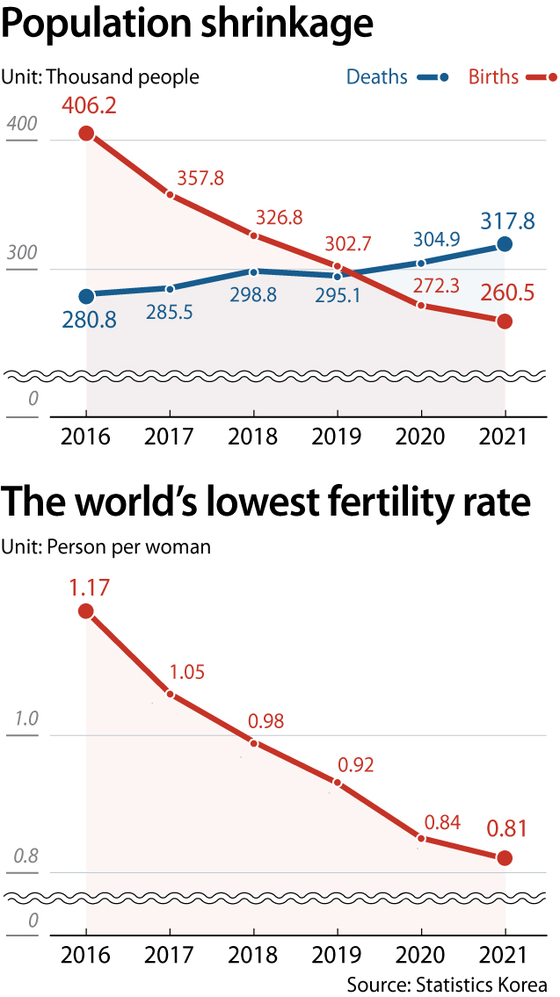Korea's births keep slowing, deaths rise

The number of newborns hit yet another new low in 2021, according to Statistics Korea. Deaths outstripped births for the second consecutive year, with the gap between the two growing wider.
A total of 260,500 births were recorded last year, a 4.3 percent decrease from 272,300 in 2020. That was 45 percent less than 2011, and less than half of 2001's 559,934.
Korea's total fertility rate – the average number of babies a woman is expected to give birth to in her lifetime – dropped for the sixth consecutive year to a record low of 0.81 births per woman, down by 0.03 from the previous year. The fertility rate dropped below one for the first time in 2018.
A United Nations Population Fund report in 2020 found that Korea ranked last among 198 countries for birthrates. In 2019, Korea was the only country in the Organisation for Economic Co-operation and Development (OECD) with a fertility rate of less than one. The average fertility rate of 38 OECD member nations was 1.61, with Spain, the country with the second-lowest fertility rate among OECD nations, recording 1.2.
The average age of first-time mothers was also the highest in Korea among OECD members.
Statistics Korea reported that the average age of mothers of newborns was 33.4 last year, up by 0.2 from 2020, as more and more people are choosing to marry late. The only age group that saw an increase in the total number of childbirths were people 40 and over, from 13,500 babies to 14,700.
Pregnancy in women aged 35 years or above reached an all-time high in 2021 as well, accounting for 35 percent of all pregnancies. In 2011, that number was only 18 percent.
A growing number of parents are choosing to have only one child. The number of second children decreased by 4.5 percent on year, to 91,300, while births of third or higher children dropped by 5.9 percent to 21,200.
The number of deaths, 317,800, outstripped the births by 57,300 last year. It was the second year in a row that deaths surpassed births, with the net population loss widened from 32,600 in 2020. The pace of population shrinkage picked up because births declined while deaths soared due to the Covid-19 pandemic and the aging of Korea's society.
Seoul recorded its first population shrinkage since 1984 when the relevant data was first compiled. Deaths in Seoul exceeded births by 3,000 people: while 45,500 babies were born, some 48,900 people died in Seoul last year.
The marriage rate also saw a significant drop. The number of newlywed couples plunged below 200,000 for the first time in 2021, to 182,509, a 9.8 percent decrease year on year. The downward curve is likely to continue.
As children are mostly born to married couples, the number of marriages directly signals how many children are expected to be born.
“A decrease in marriages over the past several years led to fewer births,” said Noh Hyung-joon, a Statistics Korea official, “and the number of marriages kept declining last year as well.“
The statistics agency predicted that the total fertility rate might plummet to 0.52 birth per woman if the marriage decline continues into 2025 and the impact of Covid-19 pandemic continues.
BY JEONG JIN-HO [shin.hanee@joongang.co.kr]










with the Korea JoongAng Daily
To write comments, please log in to one of the accounts.
Standards Board Policy (0/250자)